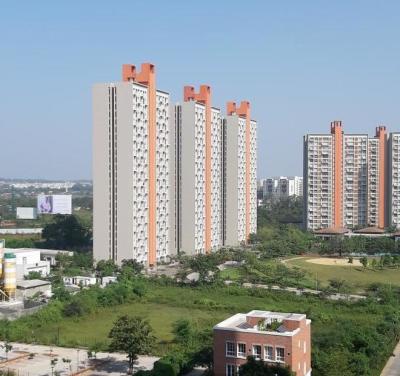The Omicron variant of the COVID-19 virus has had an unsettling impact on the stock market, with the benchmark BSE Sensex falling 1.65 percent on December 6 before staging a recovery in morning trade on December 7. The question is, will this fear have repercussions on housing demand and reverse gains made in the commercial market?
Experts say that while it is too early to predict what the implications of the yet-evolving variant would be, the impact on the real estate sector will be dependent on the severity of the situation and whether a blanket lockdown is eventually imposed or a calibrated one.
Some experts are of the opinion that Omicron could lead to a continuation of the housing trends that played out during the first two waves of the pandemic. It may lead to some people returning to work-from-home mode as companies may push back plans for a return to office. Besides, the popularity of the peripheral markets may continue for some time. Homebuyers may also decide to wait out the third wave before taking a decision to buy a house.
The new COVID-19 variant has raised concerns across the world. Many countries have re-imposed travel restrictions. In India this strain has made its appearance in some cities. The real estate market is keenly observing the development but has not demonstrated any panic so far.
“The general belief is that with the level of vaccination and other learnings the country had during the past two waves would help us to deal with the situation better if any outbreak happens,” said Subhankar Mitra, managing director, advisory services (India) at commercial real estate brokerage Colliers.
“At this time, there is no immediate threat for the residential or commercial sector. However, the situation will be clearer in the next few weeks. In case a third wave becomes imminent, there will be some disruption for a period of a few months in 2022,” he added.
Arvind Nandan, managing director, research and consulting at Savills India, a provider of commercial real estate services, says that it is too early to predict how the Omicron variant may affect the real estate sector. “It has definitely created a fear but it may take a few more days to a month to see the intensity of its impact on the economy and the overall real estate sector,” he said.
Besides, the possible impact would hinge on the intensity of lockdown, in case it is imposed. “The country has seen several types of lockdowns—the first in March 2020 was severe and brought the economy to a grinding halt. The second was more calibrated and did not impact construction activity. The impact is likely to be less in case there is a calibrated lockdown and not a complete shutdown of the economy,” Nandan added.
Experts say the future outlook of the real estate sector and the severity of the lockdown, if there is one, will depend on the state of public health infrastructure and the degree of preparedness to handle COVID-19 patients.
Niranjan Hiranandani, co-founder and managing director of property developer Hiranandani Group, is of the view that demand for home upgrades will increase as it happened after the first two waves.
“COVID-19 over a period of time will create better demand for residential real estate as more people work from home. In that respect, it will have a positive impact. Realtors have done more business in the last nine months after COVID-19 than they did in the 12 months preceding the pandemic,” Hiranandani said.
He explained that having said that, the future outlook for the sector will depend on the intensity of the lockdown, in case it is imposed. “While some states may decide to go in for a complete lockdown, others may want to impose a partial lockdown or no lockdown at all. Everything would depend on the state’s preparedness to handle COVID-19 patients and on how robust its public health infrastructure is,” he said.
Overall, there are several companies that are planning to launch projects and initial public offerings (IPOs). Listed companies are predicting a growth of 15-20 percent but it would all depend on severity of the lockdown in each state, Hiranandani told Moneycontrol.
Anuj Puri, chairman, Anarock Group, a property consultancy, said that there may be an impact on the interest rates too. “There have been expectations that the Reserve Bank of India (RBI) may raise the reverse repo rate to a nominal extent during the forthcoming monetary policy. The RR rate was reduced three times during CY2020 and the RBI would now be looking at normalising the monetary policy. However, it is likely that the RBI will hold on to the current regime in reaction to the flare-up of Omicron concerns at a time of generalised economic recovery. Therefore, home loan borrowers may enjoy the ongoing low interest rate regime for some more time. That said, an increase in repo rates and consequent increase in home loan interest rates is inevitable and will definitely take place in the future,” Puri said.
With regard to Omicron’s impact on the commercial segment, it is still too early to make any predictions. However, most urban Indians are now vaccinated. Also, December is in any case a slow month for office leasing. For now, we will have to wait and watch this space, he said.
Real estate brokers, active in the residential space, report a sudden surge in activity as demand for closing deals that have been in the works has gone up.
Dipesh Garg of Southdelhiprime.com, on online real estate brokerage, said that transactions that were in the pipeline for some months now are getting expedited as clients fear there may be a lockdown and the deal may get delayed. There is movement in case of property deals where non-resident Indians are involved too.
Amit Modi, director of Noida, Uttar Pradesh-based property developer ABA Corp., and president (elect) of industry body CREDAI, Western Uttar Pradesh, said there may be impact if there is a lockdown. “Sales may not be impacted but decisions may get delayed for a while if there is a lockdown,” he said.
He belongs to the school of thought that believes the worst is behind us and that one has to learn to live with the virus. “The worst impact on the real estate sector has already been felt. Going forward, the impact will be dependent on the length and the intensity of the lockdown if it is imposed,” he said.
This is how the numbers stacked up after the first two waves
The Delhi-NCR real estate market was one of the severely affected markets during the second wave of COVID-19 with housing sales dropping by almost 61 percent during the second quarter of 2021. New projects too were the lowest in four quarters with only 3,820 units getting launched during the second quarter, as per a report by Anarock.
The report also said launches and sales may be adversely affected in case of a possible third wave. New launches in Delhi-NCR decreased by 43 percent in the second quarter of 2021 compared to the previous quarter amid the second wave of COVID-19, Anarock said in the report.
As far as commercial property was concerned, India’s office space leasing market moved at a measured pace as most occupiers halted their expansion plans in the wake of the unanticipated second wave. In the January-June 2021 period, office absorption in six major cities stood at approximately 10.9 million sq. ft, down 38 percent from the corresponding months a year ago, Savills India said in a report.
New supply rose by 4 percent at 18.0 million sq. ft in the first half of 2021 from the year-ago period, Savills India said in the report titled India Market Watch Office. Despite the ongoing pandemic, technology (IT) occupiers continue to lead demand followed by the banking, financial services and insurance segment. While the IT sector has increased absorption and holds a 51 percent share, its combined share of approximately 63 percent is the same as in H1 2020, the report said.Bengaluru, Delhi NCR and Mumbai constituted around 69 percent of the total leasing activity in H12021 across the country’s top cities. Bengaluru continued to lead with 4.1 million sq. ft of leasing activity, representing a 37 percent share in H12021 followed by Delhi NCR which witnessed leasing activity of 2.0 million sq. ft, recording a 37 percent year-on-year decline, the report said.



































